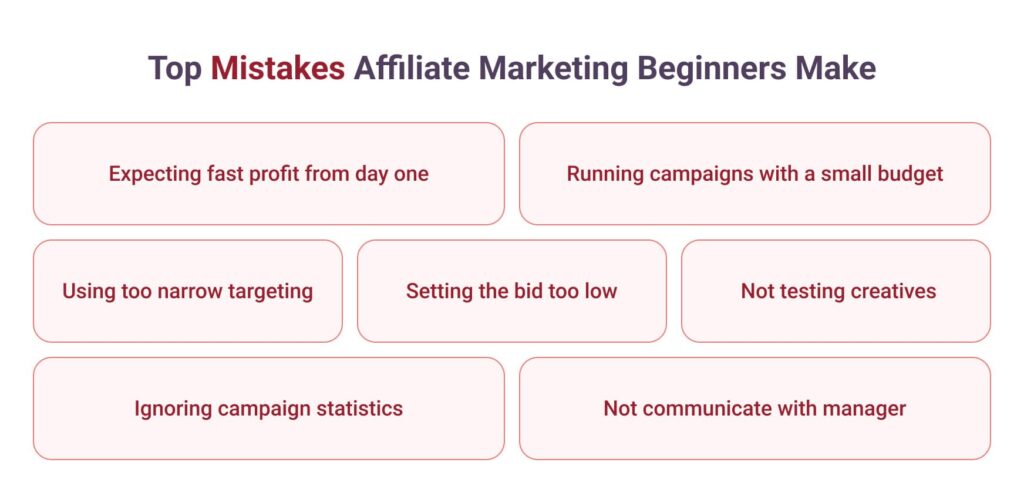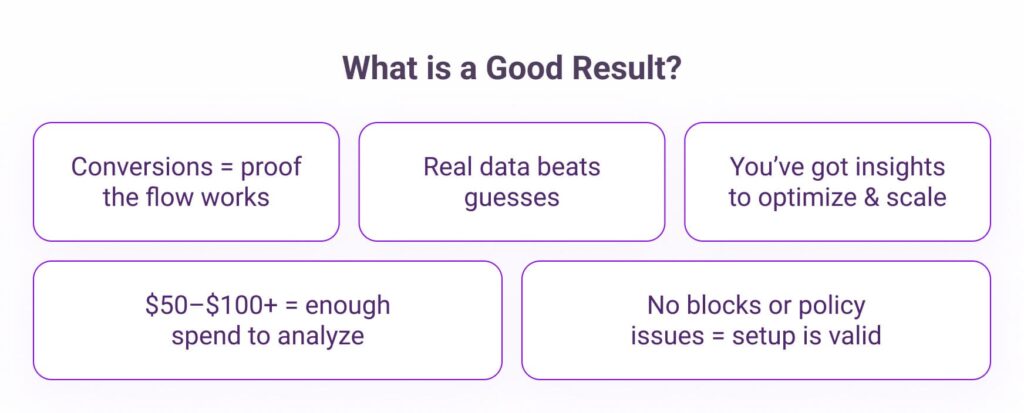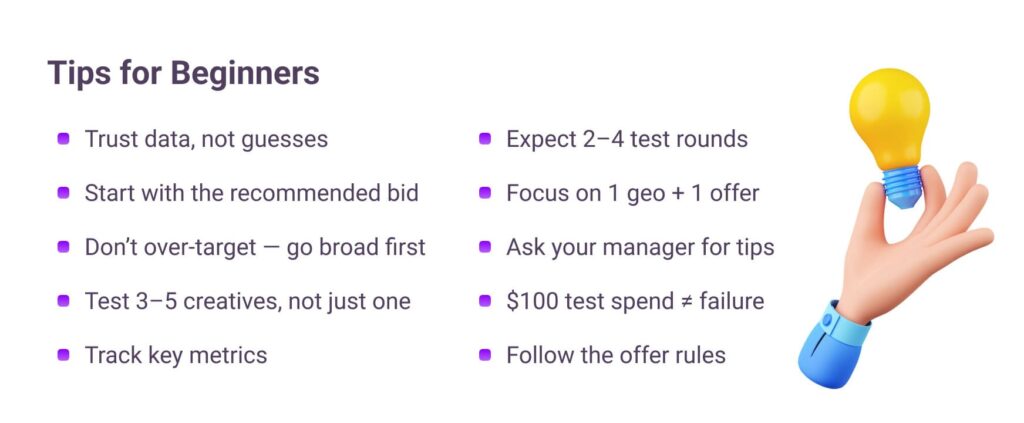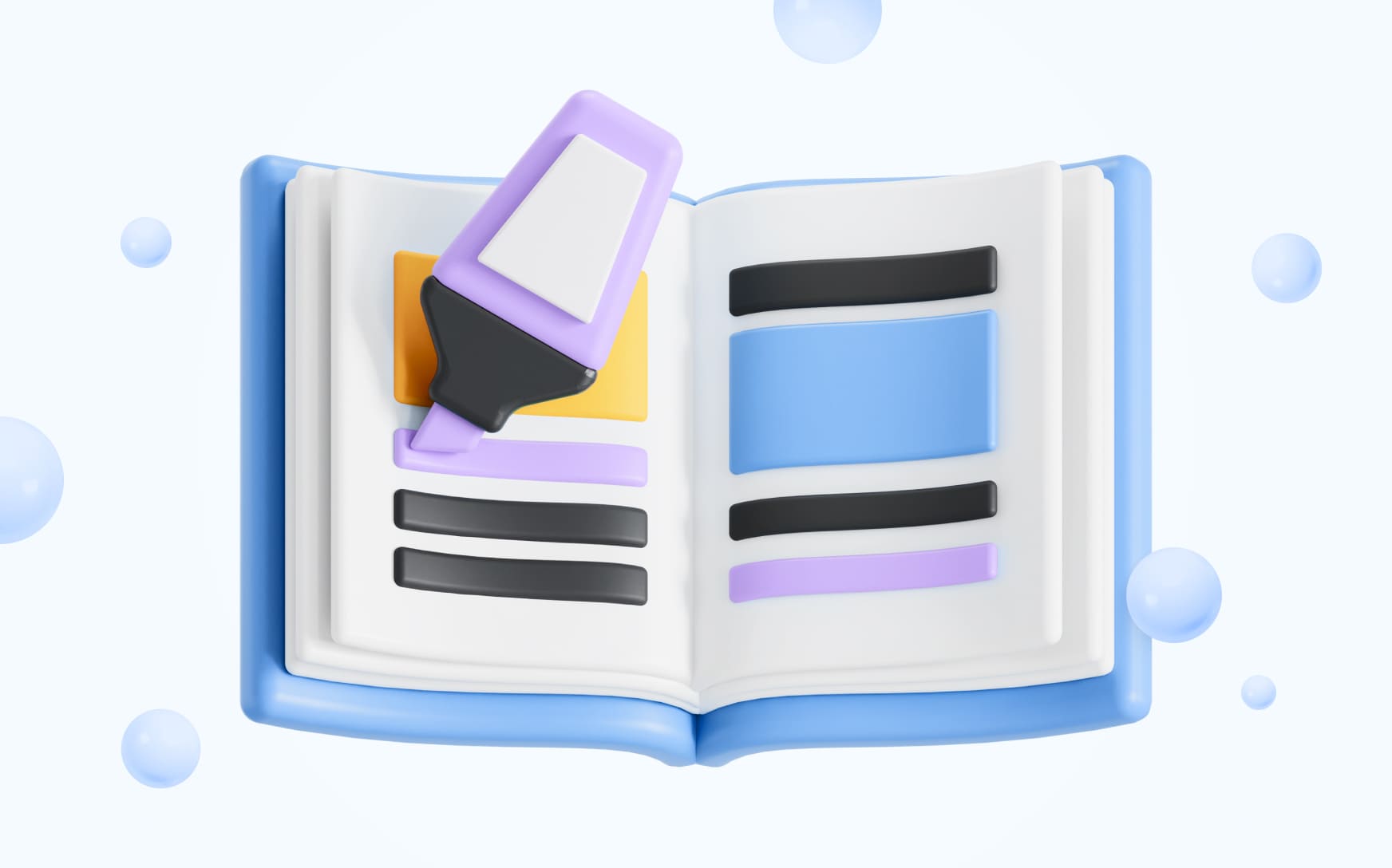Affiliate marketing in 2025 is all about testing, not instant profit. Beginners should focus on choosing one vertical, running campaigns with realistic budgets, using proper tracking and relying on data — not assumptions. The first launch is for collecting insights, not making money. With tools like ROIads ad network, new advertisers get quality traffic, expert support and everything needed to turn tests into long-term performance.
Affiliate marketing in 2025 is more accessible than ever — but that doesn’t mean it’s easy. Thousands of affiliate programs and ad networks are out there, yet most beginners fail to profit from their first campaigns. Why?
Because they expect fast results from small budgets, skip proper setup and don’t treat their first test as a learning process.
This affiliate marketing guide for beginners is here to fix that. You’ll learn what affiliate marketing is, how campaigns actually work, what realistic results look like and what tools you need to run profitable ads.

Whether you want to run dating, gambling, finance or antivirus offers — this affiliate marketing beginners guide explains the key strategies that separate trial-and-error campaigns from long-term income.
Let’s start from the beginning.
What Is Affiliate Marketing?
Affiliate marketing is a performance-based system where advertisers buy traffic to promote affiliate offers and publishers monetize their inventory by displaying ads. The goal: drive users to take specific actions — like signups, installs, deposits — and earn a payout per result.

It’s one of the most scalable ways to make money online in 2025, especially for beginners who want to start without launching their own product or service.
✅ Key players in affiliate marketing:
- Advertiser (also called a media buyer):
A person or team who runs paid ad campaigns to promote affiliate offers. They buy traffic through ad networks (like ROIads) and aim to convert that traffic into profit. - Affiliate Network / CPA Network:
The platform that provides access to affiliate offers (from direct brands or aggregators). It tracks performance and manages payouts to advertisers. - Publisher:
A traffic source owner — someone who has websites, blogs, mobile apps or other placements — and earns money by displaying ads. Publishers sell their traffic via ad networks. - Ad Network / Traffic Source (e.g., ROIads):
A platform where media buyers buy traffic. Ad networks offer formats like push, pop, native and give access to millions of daily impressions with targeting and optimization tools.
How affiliate marketing works:
- Advertiser (media buyers) gets an offer from a CPA network.
- They buy traffic from an ad network like ROIads.
- Ads are shown on placements owned by publishers (sites, apps, etc.).
- A user sees the ad, clicks and converts.
- The advertiser earns a commission — ideally higher than the traffic cost.
This process is called a conversion flow and it’s the core mechanism behind every affiliate campaign.
Key Terms for Beginners
Before you launch your first campaign you need to understand the basic terms used in affiliate marketing. This quick glossary will help you avoid confusion and make better decisions from day one.
Essential affiliate marketing terms:
- Offer
A specific deal you promote — for example, “$40 per deposit on a gambling app in Brazil.” Offers come from CPA networks. - Landing Page
The final page where the user performs the desired action (sign-up, deposit, etc.). - Pre-lander
An intermediate page before the landing page. Used to warm up or qualify users. Boosts CR in many verticals. - Conversion
The user action that triggers a payout — e.g., registration, install, or deposit. - Payout
The amount you earn per conversion. Usually fixed in CPA, but can vary in RevShare or hybrid models. - CPA (Cost Per Action)
The most common model in affiliate marketing. You get paid only when a user completes a specific action. - CTR (Click-Through Rate)
The % of users who clicked your ad. Shows how attractive your creatives are. - CR (Conversion Rate)
The % of users who converted after clicking. Important for evaluating funnel quality. - CPC / CPM
Cost models in traffic networks: CPC = cost per click; CPM = cost per 1000 impressions. - White/Blacklist
Manual list of traffic sources. Whitelist = sources that work well. Blacklist = underperformers. - Split test (A/B test)
Testing two or more creatives, landing pages, or settings to find the best-performing one.
Affiliate Marketing Examples for Beginners
To better understand how affiliate marketing works in practice, here are simple examples of typical campaigns in different verticals. Each example outlines the basic conversion flow — from ad impression to payout.
Example 1: Dating (CPL model)
Offer: $3 per registration
Traffic type: Push notifications
Flow:
- User sees a push ad with teaser text and image
- Clicks and lands on a pre-lander (optional)
- Clicks through to the dating site
- Registers an account
- You earn a commission
Example 2: Gambling (CPA model, deposit-based)
Offer: $40 per first deposit
Traffic type: Popunder
Flow:
- User lands on a casino pre-lander via popunder
- Views bonus offer or promo message
- Clicks to the landing page
- Registers and deposits
- You receive the payout
Example 3: Antivirus (CPI model)
Offer: $2.50 per install
Traffic type: Push notifications
Flow:
- User receives a system-style push alert
- Clicks and reaches the software landing page
- Installs the application
- You get paid per install
These are just a few affiliate marketing examples for beginners, but the logic is always similar: buy traffic, drive it through the right funnel, and get paid for performance. Once you understand how different verticals work, you can start testing and optimizing your own campaigns.
How to Choose an Affiliate Program or Network
As a beginner, one of the first decisions you’ll face is where to get affiliate offers. There are two main options: join a CPA network, or work directly with a brand. For most beginners, networks are the better choice.
Why start with a CPA network
- Easy access to hundreds of offers in different verticals
- No need to negotiate with each advertiser
- Ready-to-use creatives and landing pages
- Built-in tracking and reporting
- Support from affiliate managers
What to look for in a good affiliate network
- Offers in your preferred vertical (dating, gambling, finance, etc.)
- Clear and transparent terms (payouts, allowed traffic sources, geos)
- On-time payments
- Active support and guidance
- Stable tracking system
Where do advertisers launch campaigns
In affiliate marketing, advertisers (also called media buyers) use offers from CPA networks and buy traffic through advertising platforms. This is where ad networks like ROIads come in.
Short overview: Why launch with ROIads
ROIads is a global ad network focused on push and pop traffic — the two most accessible formats for beginners. With premium traffic in over 150+ geos, advanced targeting options and AI-based optimization, it’s built for performance.
- Supports top verticals: gambling, betting, dating, finance, antiviruses
- Transparent statistics and custom source optimization via Micro bidding
- CPA Goal feature for automated optimization
- AI bidding technology adjusts traffic sources in real-time for better results with less manual work
- Personal manager for deposits starting at $500
If you’re just starting out, ROIads gives you a clear path: simple interface, quality traffic and expert support to help you avoid typical mistakes.
What to Expect From Your First Campaign
Many beginners approach affiliate marketing with unrealistic expectations: spend $50 and make $200 profit in a day. In reality, the first campaign is rarely profitable — and that’s completely normal.
Your first goal isn’t profit. It’s data.
Without testing, you don’t know which creatives convert, which sources work or how users behave. The goal of a test campaign is to collect performance data — and use it for optimization.
What happens during your first launch
- You pick an offer and launch a campaign
- Traffic starts coming in
- Some users click, some convert
- You begin to see real metrics: CTR, CR, CPA
- You discover what works — and what doesn’t
Realistic outcomes
- You might not get any conversions in the first $50
- Or you may get expensive conversions that are above your target CPA
- That’s not failure — it’s a starting point
Why beginners quit too early
- Expecting instant ROI
- Launching with too narrow targeting
- Running with low bids and small budgets
- Not testing creatives
- Ignoring support from managers
Running one campaign for $100 is not enough to evaluate affiliate marketing. You need to test, optimize and repeat. Each test improves your strategy — and leads to profitability over time.
Top Mistakes Affiliate Marketing Beginners Make
Launching affiliate marketing without understanding the mechanics often leads to wasted budgets and early dropouts. Here are the most common mistakes beginners make during their first campaigns — based on real data from ROIads support experience.

1. Too narrow targeting
Beginners overfilter: selecting only one browser, OS, city or device. This limits traffic volume and slows down testing. Start broad unless your offer requires specific targeting.
2. Too low bid
Low bids = low traffic quality or no traffic at all. Always start with the recommended bid shown in the ad network’s campaign settings — it’s based on real auction data.
3. Small budget
$10-$20 budgets won’t give you enough clicks to test anything. For most verticals start with $50-$100 per campaign to get initial data.
5. Not testing creatives
One ad creative is not enough. Run at least 5–10 creatives per campaign and test different angles, headlines and images.
6. Ignoring campaign statistics
If you’re not tracking conversions, you’re flying blind. Metrics like CTR, CR and CPA are crucial for optimization. Use a tracker or at least built-in campaign stats.
7. Not communicate with manager
Every serious ad network has a manager. Skipping communication means missing out on advice, white- and blacklists and source recommendations that can save your budget.
Recommended Budgets for First Tests (per Vertical)
One of the most common questions in affiliate marketing for beginners is: How much money do I need to start?
There’s no single answer, but based on thousands of real campaigns here are the minimum test budgets recommended by ROIads. These values are realistic starting points — not guarantees of profit, but enough to collect useful data and start optimization.
| Vertical | Geo Tier | Recommended Test Budget |
| Gambling (deposit) | Tier 1 | $500+ |
| Tier 2–3 | $300+ | |
| Gambling (registration) | Tier 1 | $300+ |
| Tier 2–3 | $150+ | |
| Dating | All tiers | $250+ |
| Finance | Tier 1 | $500+ |
| Tier 2–3 | $300+ | |
| Antivirus | All tiers | $500+ |
| MVAS | All tiers | $150+ |
| Media | All tiers | $250+ |
Important notes:
- Budgets are per geo. Testing multiple countries requires higher total spend.
- These numbers don’t guarantee ROI. The goal of the first test is to get conversions, collect data and find working geo, creative and traffic source.
- Don’t pause campaigns too early. Often the second test with improved settings is what brings real profit.
This table is part of any affiliate marketing beginners guide — showing what to expect in real-world testing.
Why Tracking Is Crucial
One of the biggest differences between beginner and advanced affiliate marketers is tracking. Without it you’re guessing, with it you’re optimizing.
Even if you’re using just one traffic source and one offer, tracking shows you what works, where and why. That’s what allows you to scale and maintain profitability.
Why tracking matters
- Tracks every click, conversion and source
- Shows real CPA per placement
- Builds blacklists and whitelists
- Enables split-testing creatives and landing pages
- Allows fast optimization when traffic starts to scale
Can you run campaigns without a tracker?
Yes — but you’ll spend more. Without a tracker you’ll need higher test budget and stronger support from your account manager. In ROIads, managers can guide you using internal campaign stats, but having your own tracker gives you full control.
Popular trackers:
Tracking is not optional if you want to build long-term income.
What a “Good Result” Looks Like in a Test
When you run your first affiliate campaigns, everything is judged by ROI. But in reality, the first test isn’t about profit — it’s about learning.

Here’s what a good result actually means for affiliate marketing beginners:
1. You get conversions
Even if the CPA is high, conversions show the flow works. You can optimize later — but you need something to optimize first.
2. You collect real traffic data
If you’ve tested multiple creatives, sources or geos and now see which ones perform better — that’s success. You’re no longer guessing.
3. You avoid campaign-blocking issues
If the campaign runs smoothly (no policy violations, rejected ads or zero traffic), it means your setup is valid — and ready for scaling or fine-tuning.
4. You’ve spent enough to evaluate performance
Testing with $10-$20 doesn’t give enough volume. A meaningful test usually starts from $50-$100 (or more, depending on vertical and geo). Check the budget table from section 8.
5. You’re ready to optimize
You now know what to blacklist, which creatives underperform and which traffic sources to scale.
What NOT to expect from a test
- Instant profit after $30
- Guaranteed ROI from one campaign
- Stable performance without any changes
- One creative working across all sources
In short: A “good” test gives you insights, not revenue. Once you have reliable data, you can apply it to improve future results — this is the foundation of real affiliate marketing success. This mindset is crucial in any beginners guide to affiliate marketing.
How to Communicate with Managers
One of the most overlooked affiliate marketing tips for beginners is this: talk to your manager.
Every serious CPA network or ad network assigns account managers. Their job is to help you run profitable campaigns — especially when you’re just starting.
Why communication matters
- They can recommend offers that convert
- They know which geo and sources are performing best right now
- They can provide whitelists and blacklists based on real stats
- They help troubleshoot campaigns (e.g. no traffic, low CR)
- They often review your campaign setup and offer optimization tips
What to ask your manager before or after launching
- Is this offer converting well in my selected geo?
- Which sources work for this vertical?
- What payout type is best here (CPA, CPL, RevShare)?
- Are there any creative examples that work?
- What’s the minimum budget to test this setup?
What beginners forget
Many new advertisers in ROIads launch campaigns, burn their budget and never ask for help. Then they quit — even though the same campaign could’ve been optimized and scaled with small changes.
By talking to your manager you get expert level insights without needing months of trial and error.
Affiliate Marketing Tips for Beginners
Here are some practical tips every beginner should follow. These will save you money, reduce frustration and help you go from testing to profit faster.

1. Follow the data, not assumptions
Test, analyze, optimize based on performance — not guesses.
2. Use the recommended bid
Low bids = no traffic. Start with the suggested bid from your ad network. You can reduce it later. In ROIads, you can find average and top bids for each geo, broken down by push and pop traffic, as well as separately for mobile and desktop, in the Insight tab after singing up.
3. Don’t over-segment
Don’t add too many filters (browser, OS, city, etc.) at once. Start broad to get volume, then optimize.
4. Test at least 3–5 creatives
One banner or headline is not a test. Use variations to find what works.
5. Track everything
Use a tracker or at least monitor built-in stats: CPA, CTR, CR, EPC. Data is the only way to grow.
6. Expect multiple test rounds
Your first campaign probably won’t be profitable. That’s normal. Most successful campaigns go through 2–4 iterations before breaking even.
7. Start with 1 geo and 1 offer
Don’t spread your budget too thin. One clear test is better than three weak ones.
8. Talk to your manager
They know the platform, the traffic, and what’s converting right now. Use their experience.
9. Read the offer rules carefully
Avoid mistakes like using disallowed creatives or targeting. Stick to allow traffic types.
10. Don’t quit after your first $100
If you get traffic and conversions — you’re already ahead of most. Now it’s time to optimize.
These affiliate marketing tips for beginners are the foundation of long-term success — not hacks, just solid strategy.
Affiliate Marketing Success Stories
If you’re just getting started, one of the best ways to learn is by studying real campaigns from other affiliates.
We’ve published multiple case studies showing exactly how advertisers launched and optimized offers in different verticals using push and pop ads. These aren’t “theory” — they’re based on actual traffic, conversions, budgets and results.
You’ll find examples across gambling, finance, dating, antivirus and more — with full breakdowns of strategies, geos, ad formats and key decisions that led to profitable campaigns.
Use them as blueprints. Pick a similar offer, follow the logic, test smart — and adapt based on your own data.
ROIads ad network case studies:
Conclusion: Beginners Guide to Affiliate Marketing in 2025
Affiliate marketing still works in 2025 — but not for those who expect magic after spending $20. It works for those who test, analyze and improve. This guide was built to help affiliate marketing beginners take the right first step — informed, realistic and prepared.
You now know:
- What affiliate marketing is and how it works
- What to expect from your first campaign
- How to avoid beginner mistakes
- Why tracking matters
- What budgets make sense
- Where to find support and tested strategies
But the real learning begins only when you launch your first campaign.
If you’re looking for a platform that’s built for performance and beginner-friendly at the same time — start with ROIads.
You’ll get:
- Push and pop traffic across 150+ geos
- Smart targeting and AI-based bidding
- Transparent stats, Micro Bidding, and CPA Goal optimization
- Personal support from experienced managers
- Real case studies you can follow step by step

Roya, Emotional Damage Officer & Supreme AI Arbitragist at ROIads
FAQ: Affiliate Marketing for Beginners
What is affiliate marketing and how does it work?
It’s a performance-based model where you earn money by promoting offers and getting paid per conversion — like signups, installs, or deposits.
How do I get started with affiliate marketing?
Pick one vertical, choose an offer from a CPA network, buy traffic from an ad network like ROIads, and track results.
What are the best affiliate programs for beginners?
Look for CPA networks with beginner-friendly offers, clear rules, and manager support — such as dating, gambling, or antivirus.
How do I drive traffic to my affiliate offers?
Use paid traffic sources like push or pop ads. Start with one geo and test multiple creatives to find what converts.
What are common mistakes to avoid as a beginner?
Too low bids, narrow targeting, skipping tracking, testing with tiny budgets, and not talking to your manager.










